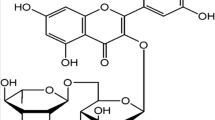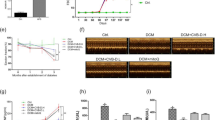Abstract
Diabetic cardiomyopathy, as one of the main cardiac complications in diabetic patients, is identified to connect with oxidative stress that is due to interruption in balance between reactive oxygen species or/and reactive nitrogen species generation and their clearance by antioxidant protection systems. Transcription factor the nuclear factor erythroid 2-related factor 2 (Nrf2) plays a significant role in maintaining the oxidative homeostasis by regulating multiple downstream antioxidants. The Nrf2 plays a significant role in ARE-mediated basal and inducible expression of more than 200 genes that can be grouped into numerous categories as well as antioxidant genes and phase II detoxifying enzymes. On the other hand, activation of Nrf2 by natural and synthetic therapeutics or antioxidants has been revealed effective for the prevention and treatment of toxicities and diseases connected with oxidative stress. Hence, recently focus has been shifted toward plants and plant-based medicines in curing such chronic diseases, as they are supposed to be less toxic. In this review, we focused on the role of some natural products on diabetic cardiomyopathy through Nrf2 pathway.
Similar content being viewed by others
Abbreviations
- Nrf2:
-
Nuclear factor erythroid 2-related factor 2
- Keap1:
-
Kelch-like ECH-associated protein 1
- PI3K/AKT:
-
Phosphatidylinositol-3-kinase/protein kinase B
- H2S:
-
Hydrogen sulfide
- NQO1:
-
NAD(P)H:quinone oxidoreductase 1
- HO-1:
-
Heme oxygenase 1
- GCLM:
-
Glutamate–cysteine ligase modifier subunit
- ERK/p38:
-
Extracellular signal-regulated kinases/p38
- TBHP:
-
tert-Butyl hydroperoxide
References
Cai, L., & Kang, Y. J. (2001). Oxidative stress and diabetic cardiomyopathy: A brief review. Cardiovascular Toxicology, 1, 181–193.
Cai, L., Wang, Y., Zhou, G., Chen, T., Song, Y., Li, X., et al. (2006). Attenuation by metallothionein of early cardiac cell death via suppression of mitochondrial oxidative stress results in a prevention of diabetic cardiomyopathy. Journal of the American College of Cardiology, 48, 1688–1697.
Boudina, S., & Abel, E. D. (2007). Diabetic cardiomyopathy revisited. Circulation, 115, 3213–3223.
Carolyn, (2015). Diabetic cardiomyopathy: An expression of stage B heart failure with preserved ejection fraction. Diabetes & Vascular Disease Research, 12(4), 234–238.
Mark Waddingham, T., Amanda Edgley, J., Tsuchimochi, H., Darren Kelly, J., Shirai, M., & James Pearson, T. (2015). Contractile apparatus dysfunction early in the pathophysiology of diabetic cardiomyopathy. World Journal of Diabetes, 6(7), 943–960.
Hamblin, M., Friedman, D. B., Hill, S., Caprioli, R. M., Smith, H. M., & Hill, M. F. (2007). Alterations in the diabetic myocardial proteome coupled with increased myocardial oxidative stress underlies diabetic cardiomyopathy. Journal of Molecular and Cellular Cardiology, 42, 884–895.
Adeghate, E. (2004). Molecular and cellular basis of the aetiology and management of diabetic cardiomyopathy: A short review. Molecular and Cellular Biochemistry, 261, 187–191.
Robertson, A. P. (2004). Chronic oxidative stress as a central mechanism for glucose toxicity in pancreatic islet beta cells in diabetes. Journal of Biological Chemistry, 279, 42351–42354.
Zhou, S., Sun, W., Zhang, Z., et al. (2014). The role of Nrf2-mediated pathway in cardiac remodeling and heart failure. Oxidative Medicine and Cellular Longevity, 1, 260429.
Erkens, R., Kramer, C. M., Luckstadt, W., Panknin, C., Krause, L., Weidenbach, M., et al. (2015). Left ventricular diastolic dysfunction in Nrf2 knockout mice is associated with cardiac hypertrophy, decreased expression of SERCA2a, and preserved endothelial function. Free Radical Biology and Medicine, 89, 906–917.
Mozaffarian, D., Benjamin, E. J., Go, A. S., et al. (2015). Heart disease and stroke statistics-2016 update: A report from the American Heart Association. Circulation, 133(4), e38–e360.
Li, H., Yao, W., Irwin, M. G., et al. (2015). Adiponectin ameliorates hyperglycemia-induced cardiac hypertrophy and dysfunction by concomitantly activating Nrf2 and Brg1. Free Radical Biology and Medicine, 84, 311–321.
Calvert, J. W., Jha, S., Gundewar, S., Elrod, J. W., Ramachandran, A., et al. (2009). Hydrogen sulfide mediates cardioprotection through Nrf2 signaling. Circulation Research, 105, 365–374.
Tian, H., Zhang, B., Di, J., Jiang, G., Chen, F., Li, H., et al. (2012). Keap1: One stone kills three birds Nrf 2, IKKbeta and Bcl-2/Bcl-xL. Cancer Letters, 325, 26–34.
Zhang, Z., et al. (2014). Sulforaphane prevents the development of cardiomyopathy in type 2 diabetic mice probably by reversing oxidative stress-induced inhibition of LKB1/AMPK pathway. Journal of Molecular and Cellular Cardiology, 77, 42–52.
Sathibabu Uddandrao, V. V., Brahmanaidu, P., & Saravanan, G. (2016). Therapeutical perspectives of S-allylcysteine: Effect on diabetes and other disorders in animal models. Cardiovascular & Hematological Agents in Medicinal Chemistry. doi:10.2174/1871525714666160418114120.
Saravanan, G., & Ponmurugan, P. (2012). Antidiabetic effect of S-allylcysteine: Effect on thyroid hormone and circulatory antioxidant system in experimental diabetic rats. Journal of Diabete and its Complications, 26, 280–285.
Brahmanaidu, P., Sathibabu Uddandrao, V. V., Pothani, S., Naik, R. R., Begum, M. S., Varatharaju, C., et al. (2016). Effects of S-allylcysteine on biomarkers of polyol pathway in experimental type II diabetes in rats. Canadian Journal of Diabetes, 40, 442–448.
Padiya, R., & Banerjee, S. K. (2013). Garlic as an anti-diabetic agent: Recent progress and patent reviews. Recent Patents on Food, Nutrition & Agriculture, 5, 105–127.
Das, D. K. (2007). Hydrogen sulfide preconditioning by garlic when it starts to smell. The American Journal of Physiology-Heart and Circulatory Physiology, 293, 2629–2630.
Erejuwa, O. O., Sulaiman, S. A., AbWahab, M. S., Sirajudeen, K. N., Salleh, S., et al. (2012). Honey supplementation in spontaneously hypertensive rats elicits antihypertensive effect via amelioration of renal oxidative stress. Oxidative Medicine and Cellular Longevity, 2012, 374037.
Palsamy, P., & Subramanian, S. (2011). Resveratrol protects diabetic kidney by attenuating hyperglycemia-mediated oxidative stress and renal inflammatory cytokines via Nrf2–Keap1 signaling. Biochimica et Biophysica Acta, 1812, 719–731.
Amagase, H., Petesch, B. L., Matsuura, H., Kasuga, S., & Itakura, Y. (2001). Intake of garlic and its bioactive components. Journal of Nutrition, 131, 955S–962S.
Motohashi, H., & Yamamoto, M. (2004). Nrf2–Keap1 defines a physiologically important stress response mechanism. Trends in Molecular Medicine, 10, 549–557.
Reuland, D. J., McCord, J. M., & Hamilton, K. L. (2013). The role of nrf2 in the attenuation of cardiovascular disease. Exercise and Sport Sciences Reviews, 41, 162–168.
Hiramatsu, K., Tsuneyoshi, T., Ogawa, T., & Morihara, N. (2016). Aged garlic extract enhances heme oxygenase-1 and glutamate–cysteine ligase modifier subunit expression via the nuclear factor erythroid 2-related factor 2-antioxidant response element signaling pathway in human endothelial cells. Nutrition Research, 36, 143–149.
Kundu, J. K., & Surh, Y. J. (2008). Inflammation: Gearing the journey to cancer. Mutation Research, 659, 15–30.
Sun, Z., Chin, Y. E., & Zhang, D. D. (2009). Acetylation of Nrf2 by p300/CBP augments promoter-specific DNA binding of Nrf2 during the antioxidant response. Molecular and Cellular Biology, 29, 2658–2672.
Nioi, P., McMahon, M., Itoh, K., Yamamoto, M., & Hayes, J. D. (2003). Identification of a novel Nrf2-regulated antioxidant response element (ARE) in the mouse NAD(P)H:quinone oxidoreductase 1 gene: Reassessment of the ARE consensus sequence. Biochemical Journal, 374, 337–348.
Kohda, K., Goda, H., Itoh, K., Samejima, K., & Fukuuchi, T. (2013). Aged garlic extract reduces ROS production and cell death induced by 6-hydroxydopamine through activation of the Nrf2–ARE pathway in SH-SY5Y cells. Pharmacology & Pharmacy, 4, 31–40.
Khatua, T. N., Adela, R., & Banerjee, S. K. (2013). Garlic and cardioprotection: Insights into the molecular mechanisms. Canadian Journal of Physiology and Pharmacology, 91, 448–458.
Hatcher, H., Planalp, R., Cho, J., Torti, F. M., & Torti, S. V. (2008). Curcumin: From ancient medicine to current clinical trials. Cellular and Molecular Life Sciences. CMLS, 65, 1631–1652.
Li, W., Wu, M., Tang, L., et al. (2014). Novel curcumin analogue 14p protects against myocardial ischemia reperfusion injury through Nrf2-activating anti-oxidative activity. Toxicology and Applied Pharmacology. doi:10.1016/j.taap.2014.12.001.
Baird, L., & Dinkova-Kostova, A. T. (2011). The cytoprotective role of the Keap1–Nrf2 pathway. Archives of Toxicology, 85, 241–272.
Kaspar, J. W., Niture, S. K., & Jaiswal, A. K. (2009). Nrf 2:INrf2 (Keap1) signaling in oxidative stress. Free Radical Biology and Medicine, 47, 1304–1309.
Calvert, J. W., Elston, M., Nicholson, C. K., et al. (2010). Genetic and pharmacologic hydrogen sulfide therapy attenuates ischemia-induced heart failure in mice. Circulation, 122(1), 11–19.
Shehzad, A., & Lee, Y. S. (2013). Molecular mechanisms of curcumin action: Signal transduction. BioFactors, 39, 27–36.
Niture, S. K., & Jaiswal, A. K. (2011). INrf2 (Keap1) targets Bcl-2 degradation and controls cellular apoptosis. Cell Death and Differentiation, 18, 439–451.
Ashrafian, H., Czibik, G., Bellahcene, M., Aksentijevic, D., et al. (2012). Fumarate is cardioprotective via activation of the Nrf2 antioxidant pathway. Cell Metabolism, 15, 361–371.
Zheng, H., et al. (2011). Therapeutic potential of Nrf2 activators in streptozotocin-induced diabetic nephropathy. Diabetes, 60, 3055–3066.
Wu, H., et al. (2015). Metallothionein plays a prominent role in the prevention of diabetic nephropathy by sulforaphane via up-regulation of Nrf2. Free Radical Biology and Medicine, 89, 431–442.
Tsuda, H., Ohshima, Y., Nomoto, H., Fujita, K., Matsuda, E., Iigo, M., et al. (2004). Cancer prevention by natural compounds. Drug Metabolism and Pharmacokinetics, 19, 245–263.
Femia, A. P., Caderni, G., Vignali, F., Salvadori, M., Giannini, A., Biggeri, A., et al. (2005). Effect of polyphenolic extracts from red wine and 4-OH-coumaric acid on 1,2-dimethylhydrazine-induced colon carcinogenesis in rats. European Journal of Nutrition, 44, 79–84.
Yeha, C.-T., Chingb, L.-C., & Yen, G.-C. (2009). Inducing gene expression of cardiac antioxidant enzymes by dietary phenolic acids in rats. Journal of Nutritional Biochemistry, 20, 163–171.
Leung, L., Kwong, M., Hou, S., Lee, C., & Chan, J. Y. (2003). Deficiency of the Nrf1 and Nrf2 transcription factors results in early embryonic lethality and severe oxidative stress. The Journal of biological chemistry, 278, 48021–48029.
Iida, K., Itoh, K., Kumagai, Y., Oyasu, R., Hattori, K., Kawai, K., et al. (2004). Nrf2 is essential for the chemopreventive efficacy of oltipraz against urinary bladder carcinogenesis. Cancer Research, 64, 6424–6431.
Lee, J. M., Li, J., Johnson, D. A., Stein, T. D., Kraft, A. D., Calkins, M. J., et al. (2005). Nrf2, a multi-organ protector? FASEB Journal, 19, 1061–1066.
Martin, D., Rojo, A. I., Salinas, M., Diaz, R., Gallardo, G., Alam, J., et al. (2004). Regulation of heme oxygenase-1 expression through the phosphatidylinositol 3-kinase/Akt pathway and the Nrf2 transcription factor in response to the antioxidant phytochemical carnosol. The Journal of biological chemistry, 279, 8919–8929.
Keum, Y. S., Yu, S., Chang, P. P., Yuan, X., Kim, J. H., Xu, C., et al. (2006). Mechanism of action of sulforaphane: Inhibition of p38 mitogen-activated protein kinase isoforms contributing to the induction of antioxidant response element-mediated heme oxygenase-1 in human hepatoma HepG2 cells. Cancer Research, 66, 8804–8813.
Acknowledgements
The authors thank for the management of K.S. Rangasamy College of Arts and Science (Autonomous) and Department of Science and Technology (DST-SERB) for providing financial support for this work (Ref No: SR/SO/HS/0227/2012).
Author information
Authors and Affiliations
Corresponding author
Ethics declarations
Conflict of interest
We declare that there is no competing financial interest for this work.
Rights and permissions
About this article
Cite this article
Sathibabu Uddandrao, V.V., Brahmanaidu, P., Nivedha, P.R. et al. Beneficial Role of Some Natural Products to Attenuate the Diabetic Cardiomyopathy Through Nrf2 Pathway in Cell Culture and Animal Models. Cardiovasc Toxicol 18, 199–205 (2018). https://doi.org/10.1007/s12012-017-9430-2
Published:
Issue Date:
DOI: https://doi.org/10.1007/s12012-017-9430-2




